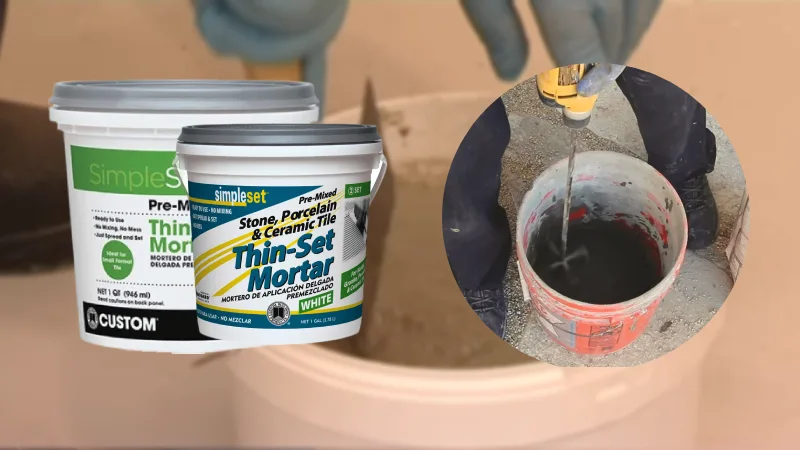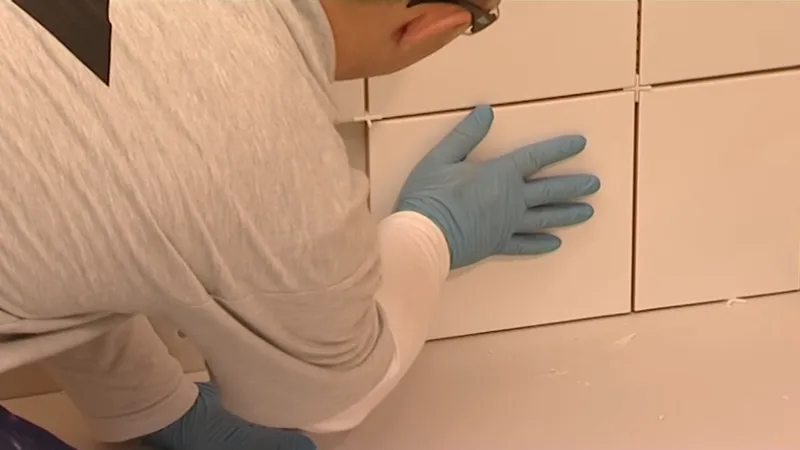Premixed Thinset Vs Mix It Yourself [Which is Better?]

Thinset is a type of adhesive that is used to install tiles. It is specifically formulated to be used in tile installation because it is strong, durable, and able to bond well with both the tiles and the substrate. Thinset is applied to the substrate in a thin layer and the tiles are pressed into it, forming a secure bond.
There are two main types of thinset: premixed and mix-it-yourself. Premixed thinset is a premixed adhesive that is ready to use straight out of the tub or bucket. It is often more convenient for do-it-yourselfers as it requires no mixing.
It can be more expensive and harder to handle due to its weight. On the other hand, mix-it-yourself thinset is a powder that must be mixed with water to create a mortar. It is typically less expensive than premixed thinset, but requires more time and effort to mix.
In this article, we will explore the differences between premixed and mix-it-yourself thinset in order to help you decide which one is best for your specific needs. We will look at the composition and curing process of each type of thinset, the recommended uses, and the cost and convenience factors.
By the end of this article, you will have a better understanding of the pros and cons of each type of thinset and be able to make an informed decision about which one is right for your tile installation project.
You'll Learn About
Premix Thinset vs Mix-it-Yourself
Premixed thinset is a premixed adhesive that is ready to use straight out of the tub or bucket. It is often more convenient for do-it-yourselfers as it requires no mixing, but it can be more expensive and harder to handle due to its weight.
On the other hand, mix-it-yourself thinset is a powder that must be mixed with water to create a mortar. It is typically less expensive than premixed thinset, but requires more time and effort to mix.
There are a few key differences between premixed and mix-it-yourself thinset that you should consider when deciding which one to use.

Composition of the Thinset
One of the main differences is the composition of the thinset. Premixed thinset is usually made from a mixture of sand and adhesive, while mix-it-yourself thinset is made from portland cement and other ingredients.
This means that premixed thinset relies on the adhesive drying out in order to harden, while mix-it-yourself thinset hardens through a chemical reaction. This can affect the strength and durability of the thinset, with mix-it-yourself thinset typically being stronger and more durable.
Recomanded Usage
Another important difference between premixed and mix-it-yourself thinset is the recommended uses. Premixed thinset is generally not recommended for use in wet areas or for tiles larger than 6×6, while mix-it-yourself thinset is suitable for both of these applications.
This is because premixed thinset may not cure properly in wet environments, while mix-it-yourself thinset is specifically formulated to withstand these conditions.
Specific Needs
Ultimately, the choice between premixed and mix-it-yourself thinset will depend on your specific needs and preferences. If you are looking for convenience and ease of use, premixed thinset may be the better option.
However, if you are looking for the strongest and most durable adhesive, mix-it-yourself thinset is probably the better choice. It is always a good idea to read the manufacturer’s specifications and follow the recommended guidelines for the specific product you are using.
Composition And Curing Process
One of the main differences between premixed and mix-it-yourself thinset is the composition of the adhesive. Premixed thinset is usually made from a mixture of sand and adhesive, while mix-it-yourself thinset is made from portland cement and other ingredients.
Composition
The composition of the thinset can have an impact on its strength and durability. Premixed thinset relies on the adhesive drying out in order to harden, while mix-it-yourself thinset hardens through a chemical reaction.
This means that premixed thinset may not be as strong or durable as mix-it-yourself thinset, which is specifically formulated to withstand the rigors of tile installation.
Curing Process
Another important factor to consider is the curing process of each type of thinset. Premixed thinset depends solely on the water-based adhesive drying out in order to harden. If the tile is going over a waterproof surface, it could take weeks for the premixed thinset to cure.
Doesn’t Requre Drying
On the other hand, mix-it-yourself thinset starts curing as soon as it gets wet and does not require drying in order to cure. This means that mix-it-yourself thinset may be a better choice for wet environments or for installations where the tiles need to be used quickly.

Overall, the composition and curing process of premixed and mix-it-yourself thinset can have a significant impact on the strength and durability of the adhesive. While premixed thinset may be more convenient, mix-it-yourself thinset is typically stronger and more durable.
Recommended Uses
Another important factor to consider when deciding between premixed and mix-it-yourself thinset is the recommended uses for each type of adhesive.
Where to Use?
Premixed thinset is generally not recommended for use in wet areas or for tiles larger than 6×6. This is because premixed thinset may not cure properly in wet environments and may not be strong enough to support larger tiles.
On the other hand, mix-it-yourself thinset is suitable for both of these applications. It is specifically formulated to withstand wet conditions and can be used with tiles of all sizes. In fact, mix-it-yourself thinset is the preferred choice for many professionals due to its strength and durability, especially in wet areas or for large tiles.
Thinset May Vary
It is important to note that the recommended uses for premixed and mix-it-yourself thinset may vary depending on the specific product you are using.
It is always a good idea to read the manufacturer’s specifications and follow the recommended guidelines for the specific product you are using. This will help ensure that you get the best results and that your tiles are installed properly and securely.
Which is Better?
If you are planning to install tiles in a wet area or with tiles larger than 6×6, mix-it-yourself thinset is likely the better choice due to its suitability for these applications. However, if you are working with smaller tiles in a dry area, premixed thinset may be a more convenient option.
Cost And Convenience
One of the main differences between premixed and mix-it-yourself thinset is the cost and convenience of each type of adhesive.
Cost
Premixed thinset is typically more expensive than mix-it-yourself thinset, but it is also much easier to use. It requires no mixing and is ready to use straight out of the tub or bucket. This makes it an excellent choice for do-it-yourselfers who want a quick and easy solution for their tile installation project.
convenience
However, the convenience of premixed thinset comes with a higher price tag. It is generally more expensive than mix-it-yourself thinset, which is sold in a powder form and must be mixed with water to create a mortar. Mixing the thinset requires more time and effort, but it is generally less expensive than premixed thinset.
Weight
Another factor to consider is the weight of the thinset. Premixed thinset is often heavier and harder to handle due to its wet and sticky nature. Mix-it-yourself thinset is lighter and easier to work with, especially if you mix smaller batches.
Specific Needs
Overall, the choice between premixed and mix-it-yourself thinset will depend on your specific needs and preferences. If you are looking for convenience and ease of use, premixed thinset may be the better option.
However, if you are looking for the most cost-effective solution, mix-it-yourself thinset is probably the better choice. It is always a good idea to weigh the pros and cons of each type of thinset and consider your specific needs and budget before making a decision.

When to Choose Premix and When Mix-it-Yourself?
Here are a few additional tips to consider when choosing between premixed and mix-it-yourself thinset:
Consider The Thickness Of The Thinset
Mix-it-yourself thinset is typically applied in a thicker layer than premixed thinset, which can make it easier to work with and more forgiving if you make a mistake. However, it is important to follow the manufacturer’s guidelines for the recommended thickness of the thinset, as applying it too thick or too thin can affect the strength and durability of the adhesive.
Think About The Coverage Area
Premixed thinset often has a shorter shelf life than mix-it-yourself thinset, which can make it less suitable for large coverage areas. If you are working on a large project, it may be more cost-effective to use mix-it-yourself thinset, as it can be stored for longer periods of time and mixed as needed.
Consider The Drying Time
Premixed thinset typically has a longer drying time than mix-it-yourself thinset, as it relies on the adhesive drying out in order to harden. This can be a factor to consider if you are working on a project with a tight deadline or if you need to use the tiles quickly. Mix-it-yourself thinset starts curing as soon as it gets wet and does not require drying, which can speed up the installation process.
Check The Manufacturer’s Recommendations
It is always a good idea to read the manufacturer’s recommendations and follow the specific guidelines for the product you are using. This will ensure that you get the best results and that your tiles are installed properly and securely.
Test A Small Area
If you are unsure which type of thinset to use, it can be helpful to test a small area before committing to a larger project. This will allow you to see how the thinset performs and make an informed decision about which one is best for your needs. Overall, it is important to consider the specific needs of your project and do your research before making a decision about which type of thinset to use.
Conclusion
Premixed and mix-it-yourself thinset are two different types of adhesive that are used in tile installation. There are a few key differences between these two types of thinset that you should consider when deciding which one is right for your project.
One of the main differences is the composition of the thinset. Premixed thinset is usually made from a mixture of sand and adhesive, while mix-it-yourself thinset is made from portland cement and other ingredients.
This can affect the strength and durability of the thinset, with mix-it-yourself thinset typically being stronger and more durable.
Another important difference is the recommended uses for each type of thinset. Premixed thinset is generally not recommended for use in wet areas or for tiles larger than 6×6, while mix-it-yourself thinset is suitable for both of these applications.
There is also a difference in cost and convenience between premixed and mix-it-yourself thinset. Premixed thinset is typically more expensive but easier to use, while mix-it-yourself thinset is less expensive but requires more time and effort to mix.
Ultimately, the choice between premixed and mix-it-yourself thinset will depend on your specific needs and preferences. It is important to consider the key differences between these two types of thinset and read the manufacturer’s guidelines before making a decision. By weighing the pros and cons of each type of thinset, you can choose the one that is best suited for your tile installation project.
